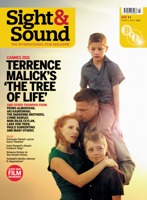Film review: Kaboom
US 2010

Reviewed by Ryan Gilbey
Synopsis
Our synopses give away the plot in full, including surprise twists.
California, the present. Smith, an 18-year-old college student, receives a card that reads: “You are the chosen son.” After taking drugs at a party he has sex with a girl called London. Leaving her apartment, he collides with a woman who is being chased by men in animal masks. He sees her stabbed and later presumes that it was a hallucination, but is worried by newspaper reports about a headless female body. Later he meets a woman who resembles the supposed victim. Smith has sex on a nudist beach with a man called Hunter. London engineers a threesome with Smith and Rex, a friend of Smith’s roommate Thor. Smith finds a website dedicated to the New World Order cult, the leader of which appears to be his dead father. London reveals that her own father was a member, and that she ingratiated herself with Smith in the hope of finding him. Smith survives an attack at his mother’s house by the men in animal masks, and finds evidence that the cult has infiltrated the media and government; he also discovers that his father had many children, including London. The animal men, unmasked as Thor, Rex and Hunter, tell Smith that they are returning him to his father, which will precipitate the end of the world. While being pursued by a drug dealer called the Messiah, intent on stopping the New World Order, the animal men are apparently killed in a car crash along with Smith and London. Smith’s father presses a red button, destroying the Earth.
Review
Gorgeous bed-hopping teens head off the apocalypse in between lessons on giving head. Just another day at the office for Gregg Araki, says Ryan Gilbey
Polysexual congress, murderous cults, drugs, incest, black magic and a teenage cast who would be rejected by Abercrombie & Fitch for excessive prettiness: Kaboom is just another day at the office for the writer-director Gregg Araki. Since helping to define the New Queer Cinema with his nihilism-for-dummies breakthrough hit The Living End (1992), he has knocked out a day-glo love letter to the West Coast’s young and feckless every couple of years. With the exception of his one literary adaptation, Mysterious Skin (2004), these pictures have adhered to a demographic-flattering format incorporating far-out visual non sequiturs and cheap but cheerful hedonism.
Having made his ‘Teenage Apocalypse‘ trilogy – Totally F***ed Up (1993), The Doom Generation (1995) and Nowhere (1997) – Araki addresses in Kaboom a literal apocalypse. Smith, a college freshman of ‘undeclared’ sexuality, witnesses a murder which prefigures the discovery that his father is an omnipotent cult leader poised to bring about the end of the world. Bummer.
The tone and production values suggest a mixture of daytime soap, gay porn and Twilight slash-fiction, but the film’s greatest asset, as ever with Araki, is sincerity. Through all manner of hysterical incident, the characters remain touchingly true and consistent, more so than in a dozen more straitlaced coming-of-age movies, as they grope their way towards fulfilment. Smith anguishes over his attraction to his ‘vag-etarian’ surfer roommate while finding happiness in the arms of the perky female partygoer London and flirting with Oliver, a student who turns out to be a psychic undercover freedom fighter (isn’t that always the way?).

It isn’t exactly irrelevant that the world is ending, a headless corpse has been discovered in a dumpster and Smith is being stalked by men in animal masks (a bit of an in-joke alongside Araki regular James Duval, who also played Frank, the six-foot rabbit in Donnie Darko (2001), another teen-centred movie with an apocalyptic bent). But it’s fair to say that Kaboom doesn’t prioritise any of those elements over the commonplace preoccupations of its bed-hopping teens. What else should we expect from a movie in which the battle for humanity is between Smith and a cult called the New World Order, names that evoke Manchester’s two greatest bands?
An aversion to the overblown can be found in the editing, which introduces detachment by framing some scenes in flashback as anecdotes recounted by characters. And it’s there in the title, which might refer equally to the numerous orgasms or to the end of cinema forecast by Smith, who observes that his film-studies course is like “studying an animal that’s on the verge of extinction”.
Nonchalant good looks can be enough to see an actor through most Araki films, so it’s a bonus that Juno Temple, as London, brings screwball sassiness and killer timing. She is the recipient of Araki’s fizziest lines (“I’ve had pelvic exams that lasted longer,” laments London, climbing off a hopeless conquest) but she can also make the simple wearing of a fez grounds for comparison with Judy Holliday. Temple delivers the picture’s most inspiring speech, in which she explains patiently to an arrogant jock precisely how to improve his oral technique. This rare example in cinema of a woman instructing a man in the administering of pleasure is enough on its own to mark the film out as more responsible and empowering than any chaste Stephenie Meyer adaptation.
See also
The pride and the passion: Brian Robinson on 25 years of the London Lesbian and Gay Film Festival (April 2011)
Wild Tigers I Have Known reviewed by Sam Wigley (July 2007)
Lonesome Cowboys: Ang Lee talks to Roger Clarke about Brokeback Mountain (January 2006)
Queer and present danger: B. Ruby Rich on the influence of the New Queer Cinema of 1992 (March 2000)
Orgazmo reviewed by Mark Sinker (April 1999)
Credits
- Director
- Gregg Araki
- Produced by
- Andrea Sperling
- Gregg Araki
- Written by
- Gregg Araki
- Director of Photography
- Sandra Valde-Hansen
- Editor
- Gregg Araki
- Production Design
- Todd Fjelsted
- Music Composed by
- Ulrich Schnauss
- Mark Peters
- Vivek Maddala
- Robin Guthrie
- Sound Designer
- Steven Avila
- Costume Design
- Trayce Gigi Field



